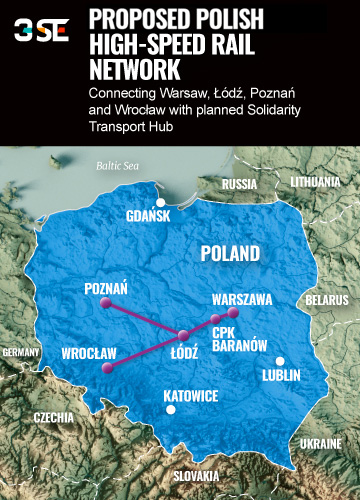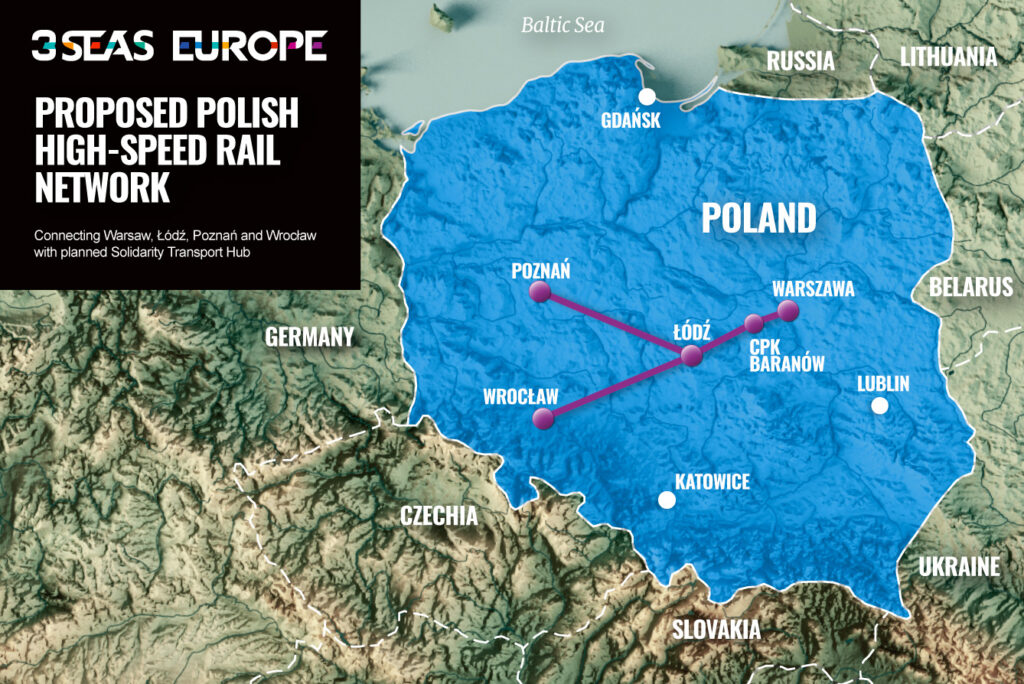Poland is building one of Europe’s largest airports, which will have a capacity to serve 100 mln passengers per year after a planned expansion. Despite being a very significant endeavor in itself, the airport that is to be located 37 km west of Warsaw is only part of a larger project named Solidarity Transport Hub (STH, in Polish: Centralny Port Komunikacyjny, or CPK).
It will serve as the primary node of Poland’s High-Speed Rail (HSR) network. Twelve railway lines will be built or modernized so that the residents of practically every sizeable Polish city will be able to reach STH within 2.5 hours.
The major railway investment program envisages the construction of 10 rail spokes that will radiate out from the airport in all directions. In total, nearly 1,800 km of HSR will be built or modernized by 2034 to a total cost of EUR 20 billion.
The new backbone of Poland’s transportation system
The core line, also known as the “Y-line” due to its shape, will connect 4 of Poland’s largest cities: Warsaw, Łódź, Wrocław, and Poznań. Trains will initially travel with speeds up to 250 km/h on this stretch but will reach 350 km/h after an upgrade.
Other HSR spokes will reach major cities such as Cracow, Katowice, Gdańsk and Lublin. Areas currently excluded from good transportation options, such as the Masurian Lake District in north-eastern Poland and the Bieszczady mountains in the south-east will also be included in the new network.
The project will also improve Poland’s connectivity with the railway systems of neighboring countries. The HSR line leading to Katowice will continue through Ostrava and Brno in the Czech Republic, Bratislava in Slovakia, and Budapest in Hungary. Wrocław will be directly connected with Prague, while an extension from Poznań will lead toward Berlin.
Eastern Poland will also gain new lines leading to Poland’s eastern neighbors. Through Rail Baltica, Poles will gain swift access to Vilnius and Kaunas in Lithuania, while other routes will lead to Minsk in Belarus, Lviv in Ukraine, and Kosice in Slovakia.
During a meeting at the Crimea Platform summit in August 2021, Ukrainian president Volodymyr Zelensky proposed to his Polish counterpart Andrzej Duda that the HSR line from Poland to Lublin should be continued by an HSR line all the way to Kyiv and that it should be built within the framework of the Three Seas Initiative.
High Speed Rail: A major economic boost for Poland
The prime ministers of the two countries also discussed the Warsaw-Kyiv HSR line during a meeting on 1 February 2022. It remains to be seen whether Ukraine will be in a position to continue preparatory work on the project in the coming years as the country might have to prioritize the reconstruction of critical infrastructure once the war with Russia ends.
The STH project is the most significant single investment in Poland’s history, and its construction is expected to significantly contribute to Poland’s economic growth in the coming decades. According to a report published by Kearney Consulting in 2020, STH will generate nearly EUR 20 bln in production and 290,000 new jobs up until the year 2040. The construction of the railway component alone will generate 30,000 jobs, plus 70,000 new jobs will be needed to keep it running.
Poland’s new HSR system will completely transform the way Poles travel, increasing their mobility while also contributing to decreasing the emission of greenhouse gasses in the process. All in all, the megaproject is bound to have a significant impact on the lives of all Poles for decades to come.









